Analyzing the Artistry of Tarot Cards
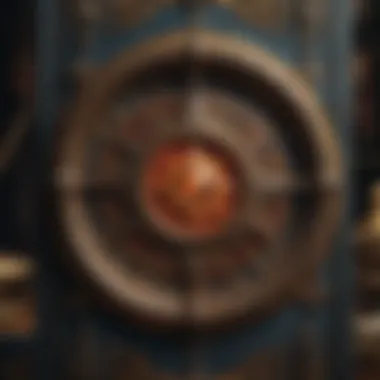
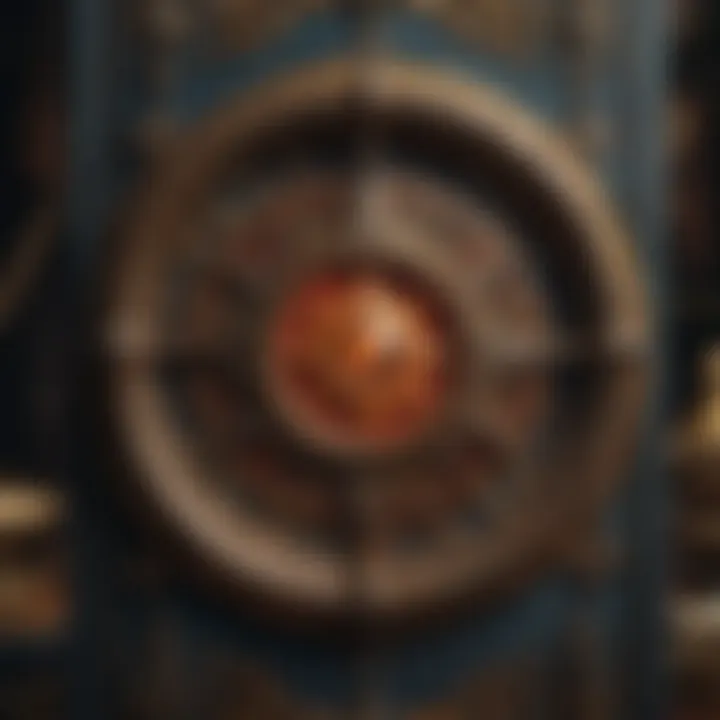
Intro
The world of tarot card artwork beckons with an allure that goes far beyond mere imagery. It’s a kaleidoscope of tradition, culture, and psychology, all interwoven in the fabric of each card. Tarot cards are not just tools for divination; they serve as artistic canvases showcasing myriad influences throughout history. In exploring tarot card artwork, we open the door to understanding not only the art but also the deeper narratives that fuel our interpretations and intuitions.
As the journey unfolds, we'll peel back layers of historical significance, artistic evolution, and cultural connotations associated with tarot imagery. When it comes to artwork, whether it’s the intricate designs of the Rider-Waite deck or the modern aesthetic of the Wild Unknown tarot, each card tells its own story through colors, symbols, and artistic choices. By examining these elements, we hope to illuminate how they enhance the readings and resonate within the intuitive mind.
Through this analysis, astrology enthusiasts and tarot practitioners alike will gain insights into how the visuals contribute to the interpretative value of tarot cards, consequently deepening their understanding of this rich practice. Let's dive deeper into this fascinating realm together, exploring not just the beauty of the art, but the profound meanings hidden in the strokes and patterns.
Prelims to Tarot Card Artwork
The topic of tarot card artwork deserves a solid exploration because it intertwines with the way we interpret the tarot. For many, tarot cards are not just a tool for divination but also a unique form of art that showcases historical, cultural, and psychological layers. The visuals on tarot cards can invoke profound feelings and stimulate rich interpretations, making the artwork a central aspect of the tarot experience. It’s not merely about the divination; it’s about understanding the artistry that speaks to the intuition and resonates deeply within us.
Definition and Overview
Tarot card artwork refers to the illustrations and designs on tarot cards, each carrying specific themes, symbols, and artistic styles. The beauty lies not only in the craft but also in the messages conveyed through imagery. Each card varies widely in its artistic representation but holds a common thread, which is to evoke inner reflection and guide personal insight. Within the realm of tarot, both novice and seasoned readers can find meaning through the intricate details of a card’s design, as these elements help shape the narrative during a reading.
Historical Origins of Tarot
The origins of tarot are shrouded in mystique and speculation, dated back to the mid-15th century in Europe. Initially created for playing card games, the tarot soon evolved into a tool for mystical guidance. The early decks often depicted Renaissance themes, influenced by the art and culture of the time. Key figures like Charles VI of France and the Visconti-Sforza family contributed to the tarot’s initial artistic expressions.
Over time, the purpose of tarot shifted from entertainment to spiritual exploration. Each deck reflected the cultural nuances of its period, driving changes in artistic styles. By the late 18th century, tarot had attracted the interest of occultists like Antoine Court de Gébelin, who linked tarot artworks to ancient Egyptian wisdom. This morphed into a blend of art and mysticism that lives on today, with artists continually transforming traditional models into modern interpretations. Through this lens, the tarot artwork serves not just as a visual aid but as a bridge connecting historical insights to today’s seekers.
"Art is a language that speaks without words; tarot cards, rich in imagery, allow our inner voices to converse beyond mere reflection."
Understanding the origins of tarot artwork helps us appreciate the depth of symbolism and the shifting paradigms within tarot practices. Learning about historical features enriches readers' interpretations and invites them to delve deeper into their readings.
Cultural Context of Tarot Art
Understanding the cultural context of tarot artwork is crucial for appreciating its significance beyond mere images on cards. Symbols and styles vary widely across different regions and traditions, reflecting ancient beliefs and practices. This context enriches the reading experience, offering deeper insights into the meanings behind each card. When one considers how diverse cultures interpret similar themes through art, it becomes clear that tarot is not just an isolated phenomenon but a tapestry of human thought and expression. Each card serves as a vessel, carrying the weight of its heritage and the echoes of voices from centuries past.
Tarot Across Different Cultures
Tarot has a fascinating journey that transcends geographical boundaries. In Europe, tarot began as a card game before evolving into a tool for divination. The artwork from the Renaissance period incorporated elements of classical myths and allegories, giving birth to decks that often mirrored artistic developments of the time.
Conversely, in Asia, tarot has absorbed influences from local spiritual practices. Decks might incorporate Buddhist motifs or Feng Shui principles. The richness of these cultural elements manifests in unique imagery that distinguishes each deck.
With the advent of localized interpretations, various indigenous communities have also produced tarot decks that reflect their traditions. Such decks may include animals, plants, or local mythology, each symbol layered with meaning specific to the culture it represents.
"The eclectic nature of tarot art illustrates the diverse lens through which humanity views its existential quest."
Symbolism in Global Traditions
Symbolism plays a pivotal role in tarot, connecting visual art with linguistic and emotional expression. While the Minor Arcana often reflects daily life situations, the Major Arcana delves into archetypical themes that resonate globally.
- Colors: Different cultures attribute varied meanings to colors. For instance, in many Eastern cultures, red is a color of prosperity and good fortune, while in Western traditions, it can represent love or warning.
- Animals: The imagery of animals also carries symbolic weight. A lion may symbolize courage in Western interpretations but might embody different traits in Eastern philosophies, such as wisdom.
- Nature: Natural elements, such as trees or rivers, often serve as metaphors for life’s journey and are interpreted through the cultural views of growth, cyclical change, and interconnectedness.
Such layered meanings invite a broader understanding of each card, allowing readers to resonate with the symbols based on their own backgrounds and experiences. In this light, tarot becomes a bridge, fostering communication across cultural divides.
Artistic Styles in Tarot Card Design
Understanding artistic styles in tarot card design opens a treasure chest of interpretation for enthusiasts and readers alike. This section is pivotal as it reveals how the choice of artistic expression influences the overall reading experience, emotional connection, and the nuances encapsulated in each card. From classical to contemporary, the artistic styles shape not just what we see, but what we feel and interpret.
Classical vs. Modern Interpretations
Classical interpretations of tarot often draw from historical symbolism and traditional art techniques. For example, decks like the Marseilles Tarot feature simplistic yet profound imagery, grounded in medieval and Renaissance art styles. Each card is meticulously designed to evoke specific archetypes and universal truths, acting as a mirror to the human psyche. The symbols employed, be they colors, shapes, or figures, are steeped in meaning that reflects a time when tarot was entwined closely with the occult and philosophical discourse.
In contrast, modern interpretations often splatter the traditional canvas with unexpected themes, colors, and styles. Artists in today’s age use technology and diverse cultural motifs to reinvent tarot. Decks like the Shadowscapes Tarot, for instance, utilize ethereal artwork reminiscent of fantasy illustrations, having flowing lines and vibrant colors that leap out. This evolution speaks volumes about the shift in cultural perspectives, inviting newcomers to explore tarot in their unique way.
"Art cannot be modern. Art is eternal." - Egon Schiele
Influence of Surrealism and Fantasy Art
Surrealism and fantasy art have cast a spell over modern tarot card designs, allowing for a free expression of the subconscious. Artists like Salvador Dalí, whose works flooded the art world in early 20th century, applied the principles of surrealism to challenge perceptions of reality. Now, tarot card makers borrow this aesthetic to push boundaries, creating decks that invite introspection and exploration of the unknown.
For example, the Dreaming Way Tarot plays with whimsical, dreamlike elements that distort and reinterpret reality. Such decks can stir the imagination, tapping into the unconscious mind and allowing users to explore deeper meanings that go far beyond the surface. Moreover, decks that incorporate fantasy themes often blend mythical creatures or magical landscapes, making each reading a journey through a visually rich tapestry. This intermingling of surrealism and fantasy encourages a dialogue with the cards that straddles between reality and imagination, pushing readers to derive personal meanings that resonate at a profound level.
Major Artists and Their Contributions
Historical Artists of Note
Throughout the rich tapestry of tarot's existence, several artists have left an indelible mark on its evolution. Each artist brought their unique perspective, shaping how tarot is perceived and utilized.
One of the most significant names in tarot history is Pamela Colman Smith, who illustrated the iconic Rider-Waite Tarot Deck in the early 1900s. Her innovative approach to design incorporated vivid imagery that resonated with readers on both a conscious and subconscious level. This deck, characterized by its intricate illustrations, has become a cornerstone for many tarot practitioners. The images she created, complete with detailed symbolism and emotional depth, provided a framework for interpreting tarot cards. Some might say that Smith's work democratized tarot, making it accessible to a broader audience through its engaging visuals and clear storytelling techniques.
Another noteworthy historical figure is Aleister Crowley, whose collaboration with artist Frieda Harris on the Thoth Tarot Deck stands as a testament to the synthesis of art and mysticism. The Thoth Deck is known for its complex symbolism, heavily influenced by Kabbalistic and astrological elements, which reflect Crowley’s esoteric philosophies. Harris’s artistic style—bold and avant-garde—encourages deep exploration and interpretation of each card’s meaning.
"Art can be a mirror reflecting the human condition; in tarot, it is also the lens through which we view our journey."
The contributions of these artists are vital. Without them, the nuanced language of tarot might have remained cloaked in ambiguity. Their works not only illuminated tarot but also expanded its reach beyond simple divination into a profound method of self-exploration and insight.
Contemporary Tarot Artists
As the wheel of time turns, new voices have emerged in the tarot community, bringing fresh perspectives and interpretations to this ancient practice. Contemporary tarot artists are now reshaping the landscape of tarot card design, each artist adding their unique flair.
One prominent figure is Lisa Sterle, known for her Modern Witch Tarot Deck. Sterle’s approach embraces inclusivity, diversity, and modern themes, transforming traditional imagery into representations that resonate with today’s audience. Her work captures not only the essence of tarot but also the varied experiences of individuals who seek guidance through these cards. The blend of modern aesthetics with classic symbolism breathes new life into tarot interpretation.
Caitlín Matthews is another contemporary force. With her Tarot of the Sidhe, Matthews delves into Celtic mythology, intertwining rich folklore with tarot practice. This deck allows users to explore deep cultural narratives through a tarot lens and exemplifies how contemporary artists are weaving their heritage into the fabric of tarot art.
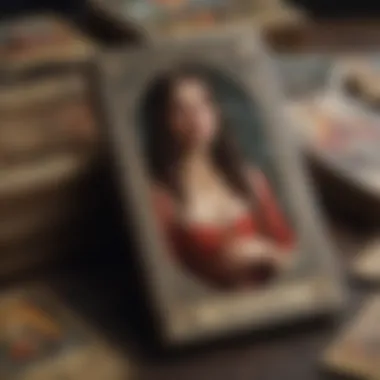
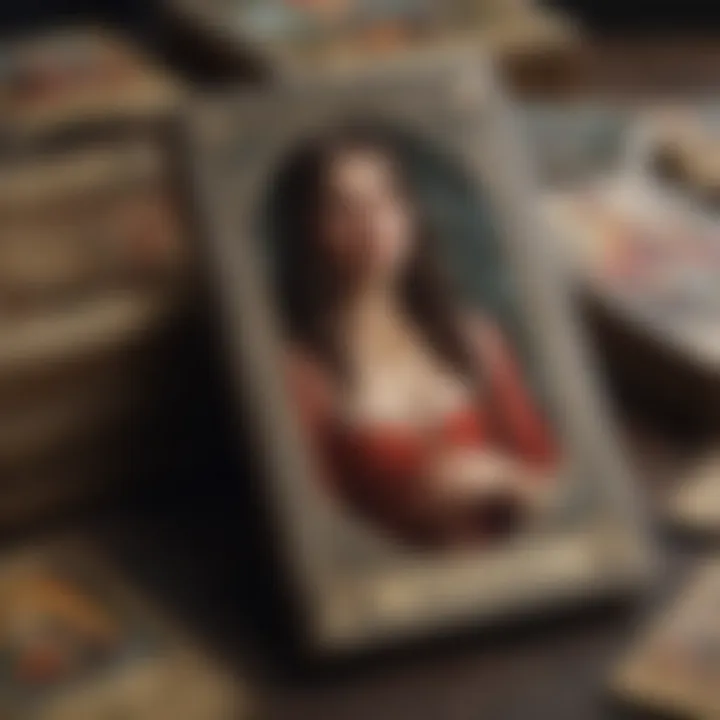
In this modern landscape, community and collaborative projects are gaining traction. Artists often engage with tarot enthusiasts on platforms like Reddit or through social media, leading to decks that reflect collective experiences and narratives. This dynamic interplay between artist and audience fosters a sense of belonging within the community, enhancing the overall tarot experience.
Overall, the contributions from both historical and contemporary artists not only enrich the tarot landscape but also bridge the past with the present. Their dedication to the craft keeps the art alive, constantly evolving while still respecting its roots. Tarot artwork remains a vital aspect of how practitioners connect with themselves and the universe around them.
Psychological Impact of Tarot Imagery
The realm of tarot imagery reaches far beyond mere aesthetics; it plays a pivotal role in shaping the mindset of both the reader and the querent. The tarot cards, adorned with various symbols and scenes, evoke a wealth of emotions and associations that can significantly influence the interpretation of readings. Understanding the psychological impact of these images not only enhances the experience of divination but also deepens the connection between the user and the deck.
Visual Interpretation in Readings
How one interprets tarot imagery can be as unique as the individual drawing the cards. The colors, shapes, and symbols all serve as prompts that ignite introspection and reflection. For instance, pulling the Seven of Cups, which often depicts a figure surrounded by floating chalices, can trigger notions of choices and possibilities. It's not just about what the card represents in tradition but also how it resonates on a personal level.
- Personal Associations: Each card can remind different people of unique experiences. A whimsical image might remind someone of childhood dreams, while for another, it may evoke a sense of nostalgia linked to family gatherings.
- Emotional Response: The artwork can elicit various emotional reactions—ranging from fear to joy to contemplation—impacting how the reading is perceived. An artistic style that seems vibrant might inspire a feeling of hope, whereas darker imagery might conjure feelings of anxiety or caution.
- Contextual Influence: Interpreting a card can change based on the context of the querent's question or state of mind. A querent seeking guidance on a relationship visualizes the imagery of, say, the Lovers, with a different lens if they currently face challenges compared to when times are harmonious.
As readers navigate their interpretations, the layers built-up through their unique experiences weave into the aspects influenced by tarot imagery, resulting in a highly subjective reading process.
Art as an Intuitive Tool
Tarot artwork acts not just as a tool for divination, but as a gateway to intuition. The visual elements present on each card serve to guide the intuitive process during readings, often leading to insights that are not derived from logical reasoning alone.
- Instinctual Responses: Many readers find that their first impression upon seeing a card can hold profound meaning. This gut reaction can serve as a compass, pointing toward deeper truths that may not initially be evident.
- Symbolic Language: The icons within tarot cards often communicate in a language that transcends words. A reader may feel called to focus on a specific symbol—like a butterfly, representing transformation—which can lead to revelations about the querent's current life circumstances.
- Imagery as Reflection: The visual aspect allows readers to project their thoughts and emotions onto the cards. This phenomenon can be particularly striking as it creates a mirror, reflecting both conscious and subconscious thoughts back to the querent. This reflection can also lead to surprising discoveries about one’s own feelings or beliefs.
In this way, tarot imagery serves as more than just decorative artwork; it becomes an essential facilitator of intuition, unveiling layers of realization and insight that words may fail to express.
"The art of tarot is the art of seeing—seeing the unseen, understanding the known, and intuitively linking the two."
Symbolism and Its Meanings
Symbolism in tarot card artwork serves as the backbone for interpretative depth, transforming mere images into a rich tapestry of meaning. Each card is a world unto itself, as every detail has been meticulously crafted to convey specific emotions, beliefs, and archetypes that resonate deeply with the beholder. Understanding this symbolism not only enhances one's grasp of tarot but adds layers of insights when reading cards, making it a crucial element in the narrative of tarot.
Elements of Design and Their Significance
Design elements in tarot art encapsulate a blend of visual language that speaks volumes without the need for words. Color, shape, line, and composition each play a pivotal role in how the cards convey their intended meanings. Here are some noteworthy aspects:
- Color: Different hues evoke varied emotional responses. For instance, red often symbolizes passion and energy, while blue is associated with calmness and intuition.
- Shape: Shapes can communicate stability, movement, or chaos. Circles can symbolize eternity and completeness, whereas sharp angles might suggest conflict or tension.
- Imagery: The figures and objects represented are not randomly placed; rather, they hold specific cultural and psychological significances. For example, the sun often represents vitality and clarity, whereas the moon signifies intuition and mystery.
- Layout: How elements are arranged within the card matters too. A centered figure might indicate a focus on balance, while off-center imagery may suggest disruption or change.
Recognizing how these elements work together enhances one’s ability to interpret the cards on a personal level. Each design choice reflects the artist's intention and can guide the reader's emotional and intuitive response to the artwork.
Interpreting Individual Symbols
Delving into the interpretation of symbols within tarot cards requires a nuanced understanding of their historical and cultural contexts. Each symbol can be multi-faceted, often possessing different meanings based on the reader's perception or the day’s context. Below are some common symbols typically found in tarot:
- The Fool: Represents new beginnings, spontaneity, and an open mind. It's often the card of potential and adventure.
- The Tower: Signifies chaos, upheaval, but also ultimately, enlightenment after significant change. The imagery often includes lightning striking, indicating sudden revelation or transformation.
- The Wheel of Fortune: A symbol of cycles and change, it often conveys the idea of fate and the ebb and flow of life.
Each time one pulls a card, the symbols invite a dialogue between the reader and the art, offering fresh interpretations and insights.
Symbols in tarot art act as mirrors reflecting the inner thoughts and circumstances of the querent. The meaning of these symbols evolves, revealing different layers with time and experience.
The Evolution of Tarot Artwork
The evolution of tarot artwork serves as a window into not just artistic trends but also the changing social and cultural perspectives surrounding tarot itself. This transformation marks a significant chapter in the story of tarot, reflecting broader technological, artistic, and societal shifts throughout history. Today, tarot cards are not merely tools for divination; they have evolved into intricate works of art that convey stories and represent the visual mindset of different eras. The trends we explore here highlight how the relationship between art and tarot develops continuously, ensuring its relevance in an ever-changing world.
Transition from Hand-Painted to Mass Production
In earlier days, each tarot deck was a labor of love, often hand-painted by skilled artisans. This process allowed for personal expression and unique artistic elements that spoke to the values and beliefs of the time. However, as demand for tarot cards grew, especially in the 18th and 19th centuries, the transition to mass production became inevitable. This shift drastically changed the landscape of tarot artwork.
Mass production enabled tarot decks to reach a wider audience. The standardization of designs led to the creation of popular decks that could be manufactured at a lower cost. For instance, the Rider-Waite Deck, introduced in 1909, set a new precedent in tarot design. It practically embedded its imagery into collective consciousness, as thousands of copies were printed and sold across the globe.
- Benefits of Mass Production:
- Accessibility: Tarot cards became affordable for the average seeker, breaking down the barriers to entry previously held by the elite.
- Familiarity: Iconic images became easily recognized, aiding in the interpretation of these symbols during readings.
- Standardization: Common themes and motifs flourished, laying the groundwork for expected symbolism in future cards.
However, there are considerations that arise from this shift. The uniqueness of individual artistic expression began to fade, with some arguing that mass production diluted the spiritual essence of the tarot. Each hand-painted card held a story and energy that mass-produced versions seem to lack. Critics often feel that these modern decks, produced at scale, carry a sense of detachment, as if they were mere reflections of a previously richer tradition.
Digital Influence on Tarot Art
Fast forward to our current digital age, where technology has dramatically reshaped everything from smaller artistic practices to established traditions like tarot. Digital art tools have ushered in a new wave of tarot creativity. Artists can now experiment with a plethora of techniques, colors, and designs without the limitations imposed by traditional mediums. From the computer screen to apps, the tarot universe has gone through a real metamorphosis.
Digital platforms have made it easier for artists to showcase their work. This has led to diverse interpretations and styles in tarot art. Artists are no longer limited by geographic constraints, allowing global collaboration and cross-cultural influences.
- Key Elements of Digital Influence:
- Interactivity: Augmented reality and animations have emerged, giving life to card readings in ways unimaginable before.
- Customizability: People can create personalized decks using their imagery, making the experience more relatable.
- Community Engagement: Social media platforms like Instagram and Reddit have become meeting grounds for creators and enthusiasts, allowing for discussions on artistic choices and interpretations.
The rise of digital technology in tarot has created immense opportunities, diversifying the art form and its accessibility while challenging traditional notions of what tarot can be.
With this evolution from personal hand-painted cards to digital creations, there’s an ever-deepening dialogue about what tarot represents. Each advancement in style and medium offers fresh insights into the ancient art of tarot, affirming its significance in both historical and modern contexts.
Case Studies of Iconic Tarot Decks
When diving into the world of tarot, it’s hard to ignore the weight of the decks that have set the standard over time. This section explores two of the most iconic tarot decks: the Rider-Waite and the Thoth. Each deck carries a universe of symbolism, artistry, and history that has fundamentally shaped how tarot is perceived and utilized today. Understanding these decks is not just about recognizing card images; it’s about connecting deeply with the narratives that they convey and the insights they unlock in readings.
Rider-Waite Tarot
The Rider-Waite Tarot deck, created by Arthur Edward Waite and illustrated by Pamela Colman Smith in the early 20th century, has become perhaps the most recognized tarot deck in existence. Its significance stems from how it revolutionized tarot imagery. Here’s why it’s pivotal:
- Symbolism: Every card in this deck is rich with symbolism. For instance, the Fool depicts a young person about to embark on a journey, embodying themes of spontaneity and adventure. This simple yet profound imagery captures complex human emotions that resonate with anyone reflecting on their path.
- Accessibility: Prior to Rider-Waite, many tarot decks relied heavily on obscure symbols that could confuse new readers. Waite's deck broke this mold, making tarot accessible to a broader audience. Each card contains a visual language that anyone can tap into, regardless of prior experience.
- Influence on Modern Tarot: This deck has paved the way for countless other decks, influencing everything from thematic focus to artistic style. Understanding the Rider-Waite deck is essential when engaging with contemporary tarot, as many decks draw upon its aesthetics and interpretations.
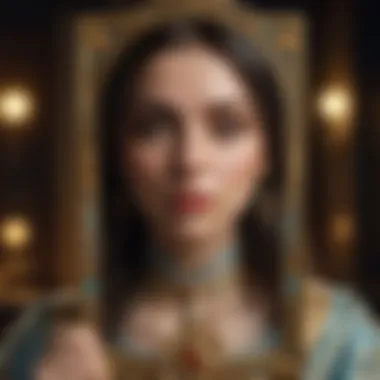
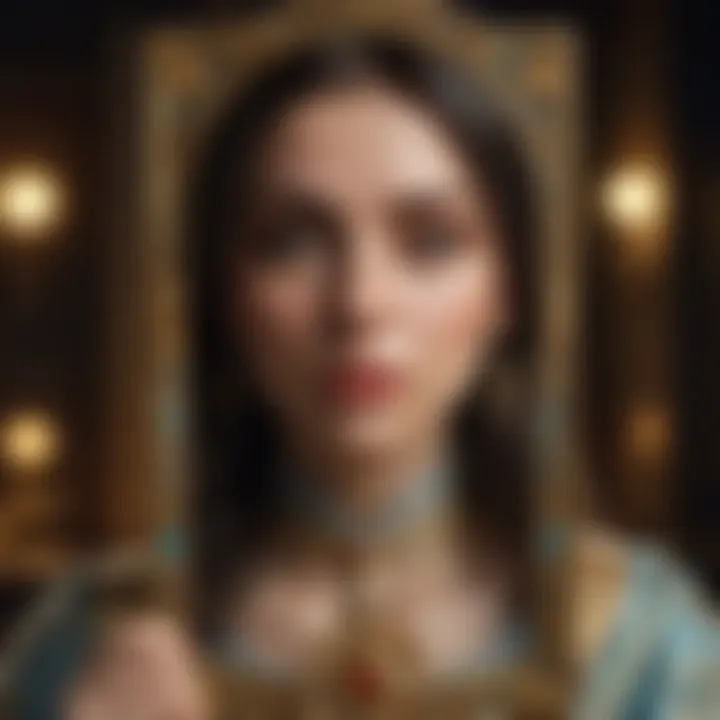
Rider-Waite also highlighted the importance of illustrations. Previously, the tarot relied more on textual and vague graphical representations. Now, the imagery leads to richer interpretations, making readings more engaging and intuitive.
"The art of tarot is like a mirror reflecting one's soul; the visual elements guide but never dictate."
Thoth Tarot
The Thoth Tarot, designed by Aleister Crowley and illustrated by Lady Frieda Harris, presents a stark contrast to the Rider-Waite. Rooted in Thelema, Crowley’s spiritual philosophy, this deck captures a complexity that speaks to deeper esoteric traditions. Here are some points to consider:
- Use of Color and Form: Each card is infused with vibrant colors and intricate details. The imagery is steeped in mysticism, drawing upon alchemical, astrological, and Qabalistic symbols. For example, the Magus card transcends the traditional representation, showcasing the transformative power of will and creation.
- Philosophical Depth: Crowley’s intent wasn’t just to create a deck; he aimed to infuse it with profound philosophical concepts. This layer of meaning invites users to not only engage with the cards but to contemplate their personal and spiritual significance. For instance, the card of The Empress is not merely about femininity but the creative force that embodies nurturing in every aspect of life.
- Impact on Tarot Community: Thoth brought a unique blend of occult knowledge to tarot reading, reshaping the tarot community's approach to esoteric studies. It caters to those looking to explore tarot on a deeper intellectual and spiritual level.
Both the Rider-Waite and Thoth Tarot decks offer essential lessons on how design, color, symbolism, and philosophy intertwine in the realm of tarot. They reflect the human experience through art, serving as tools for navigation through life’s complexities.
The Role of Color in Tarot Art
Color plays a pivotal role in the world of tarot card artwork, acting as both a bridge between intuition and message. Each hue can resonate with specific emotions, psychological states, or spiritual connotations. Tarot artists don’t choose colors on a whim; rather, they’re weaving a visual narrative that can elicit responses or guide interpretations.
Psychological Effects of Color Choices
Psychological research shows that colors can elicit strong feelings and affect our mood. In tarot, color can amplify the meanings associated with each card, enhancing the reader's experience. For instance:
- Red often stimulates feelings of passion and energy. It brings to mind the concept of action, making it commonly used in cards representing vitality or conflict.
- Blue suggests calmness and stability, soothing the viewer and often associated with intuition and healing.
- Yellow radiates cheerfulness and warmth. In the context of tarot, it can signify optimism or clarity.
When a reader examines a card, the predominant colors resonate with their psychological state. A card representing heartbreak might come with muted blues or grays, evoking a sense of sadness, while vibrant greens might be employed to symbolize growth and renewal. The ability of color to convey depth and emotion adds a layer to understanding the cards.
Cultural Significance of Color in Different Decks
Different cultures have varying associations with color, influencing tarot artwork across cultural traditions. This is evident in the choice of colors in distinct tarot decks. For example:
- The Rider-Waite Tarot leans heavily on rich, evocative colors to communicate its meanings. The bold use of red and gold might reflect the deck’s European origins, invoking feelings of luxury and celebration.
- In contrast, the Thoth Tarot by Aleister Crowley employs color in a rather different manner, often layering complex meanings into the design. Crowley's use of color is more psychological, emphasizing the interplay of mind and spirit.
- Similarly, decks inspired by Eastern philosophies might incorporate colors aligned with specific cultural symbols or spiritual teachings; for instance, orange may symbolize spiritual awakening.
The cultural significance of color isn’t just aesthetic; it often carries a deeper message woven through tradition and shared beliefs.
"Color is a power which directly influences the soul."
— Wassily Kandinsky
As the tarot landscape continues to evolve, understanding the role of color provides a foundation for interpreting the decks we hold, interpretations colored with the context of our own psychological and cultural landscapes.
The Modern Tarot Art Movement
The modern tarot art movement marks a paradigm shift in how tarot cards are created, perceived, and utilized in the 21st century. Key elements of this movement include the emergence of new styles and themes that resonate with a diverse audience, expanding the reach of tarot beyond traditional boundaries. This transformation hinges on various benefits such as enhanced personal connections to the cards, greater artistic freedom among creators, and the fostering of a community dedicated to exploring the multifaceted nature of tarot.
Traditional tarot decks often echo historical conventions, yet contemporary artists are known to break these molds. With a burgeoning number of creators expressing their unique visions, tarot artwork now showcases a plethora of interpretations that invite introspection and exploration. The significance of these modern works goes beyond visual appeal; they challenge users not only to read the cards but to engage with them on a deeper, more personal level.
Emergence of New Styles and Themes
The tarot cards of today feature an array of styles that reflect the broader artistic movements of our time. From minimalist designs that speak to simplicity, to intricate, detailed illustrations bursting with symbolism, new styles emerge regularly. These innovations capture the spirit of a generation eager for connection and understanding, illustrating how the modern tarot is a canvas for expression.
Specific characteristics of modern tarot art include:
- Inclusivity: Many contemporary decks represent a broader spectrum of identities, cultures, and experiences. This inclusivity is paramount in making tarot accessible and relatable to individuals from all walks of life.
- Abstract and Non-Traditional Themes: Some decks venture into abstract or conceptual interpretations of traditional symbols. Such interpretations may include themes like technology, spacescapes, or socio-political commentary, turning tarot into a mirror reflecting contemporary societal concerns.
- Personal and Intimate: Artists frequently infuse personal experiences and emotions into their work, creating decks that resonate more deeply with users.
This interplay of personal expression and collective ethos underscores how modern tarot art transcends mere aesthetics to become a potent tool for self-discovery.
Community and Collaborative Decks
The sense of community within the modern tarot movement cannot be overstated. Platforms such as social media and forums create spaces for communication among artists and aficionados, fostering collaboration and the exchange of ideas. Online communities offer the opportunity to share insights, techniques, and personal stories related to tarot.
One of the outcomes of this communal approach is the rise of collaborative tarot decks, where multiple artists contribute to a single deck. Example benefits of these collective efforts include:
- Diverse Range of Artistry: Each artist brings their own unique flair, creating a multifaceted visual narrative that might not be possible in a solo project.
- Emphasis on Collective Experience: These decks often explore shared themes or concepts, such as empathy or resilience, creating a cohesive yet varied experience for readers.
- Crowdfunding Opportunities: Artists have embraced platforms like Kickstarter to fund collaborative projects, which not only democratizes the creation process but also allows community members to invest in projects that resonate with them.
The modern tarot art movement, characterized by its diverse styles and community spirit, illustrates how art continues to evolve in tandem with society. In this new landscape, tarot cards serve not just as tools for divination but as vibrant reflections of our times.
Analyzing Tarot Decks for Beginners
When venturing into the world of tarot, understanding the intricacies of tarot decks is crucial for both novices and seasoned practitioners alike. This comprehensive analysis serves to bridge the gap between artistic expression and practical application, emphasizing how the right deck can fundamentally transform one’s tarot experience. Each deck not only tells a story through its visuals but also embodies the artist's interpretation, making the selection process a deeply personal journey.
Choosing the Right Deck for Personal Use
Selecting the right tarot deck can feel overwhelming, given the multitude of options available today. Each deck varies not just in art style but also in symbolism, themes, and intuition. For beginners, it’s important to consider a few guiding factors:
- Intuition and Connection: Choose a deck that resonates with you on some level. Sit with the cards, hold them, and notice how you feel. Often, the imagery that captures your attention will lead to a stronger reading experience.
- Artistic Style: Different artists lend various emotional tones to their work. For instance, the Rider-Waite deck features classic, straightforward imagery that is widely adored, while modern decks might explore abstract themes or vibrant colors that might appeal more to your tastes.
- Theme and Focus: Some decks are themed, like animal tarot, nature, or even cosmic aesthetics. Think about which themes you connect with personally. This can enhance your reading and make the experience sweeter.
- Guidance Resources: Some beginner decks come with in-depth guides, illustrations, or keywords that can help you translate your readings better. This is particularly helpful for those still learning the foundational meanings of each card.
Ultimately, choosing a tarot deck isn’t just about aesthetics; it’s about personal connection and the willingness to explore the narratives woven into each card.
Understanding Visual Cues in Readings
Once a beginner has chosen their deck, the next step is to delve into understanding visual cues. Every image on the cards is intentional, loaded with symbols that can speak volumes during a reading. Observing the nuances of each card will aid the learner in interpreting messages more effectively:
- Colors: Colors evoke emotions and feelings. For instance, red could symbolize passion or urgency, while blue might resonate with calmness or intuition. Each deck will have its own color palette that contributes to the overall meaning of the cards.
- Imagery and Symbols: Take note of recurring symbols, such as swords, cups, or nature elements. These often relate to broader themes in tarot, like action, emotions, or growth. Each symbol has a generalized meaning, and recognizing these can enhance reading clarity.
- Card Positioning: In spreads, how a card is oriented—upright or reversed—can drastically change its meaning. Make note of whether the card evokes feelings of shadow work or light—this could guide the interpretation.
- Body Language of Figures: If the card features human figures, their posture or facial expression can speak for the emotional undertone of the situation the card represents. A serene face might imply resolution, while a figure looking away might suggest conflict.
"Understanding tarot is not just about knowing the cards but feeling their essence and connection to your life."
Engaging closely with visual cues allows the reader to bridge the gap between the mundane and the esoteric. As one becomes adept at recognizing these signals, it will inevitably enhance the effectiveness of personal readings.
The Interface of Tarot and Digital Media
The digital age has woven itself into countless aspects of life, and tarot is no exception. The intersection between tarot and digital media brings forth a host of new opportunities for both enthusiasts and practitioners. As the world evolves, so do the accessible means through which tarot can be explored, shared, and utilized.
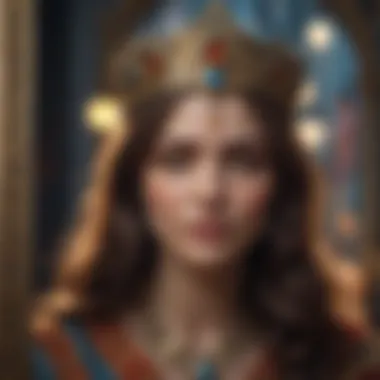
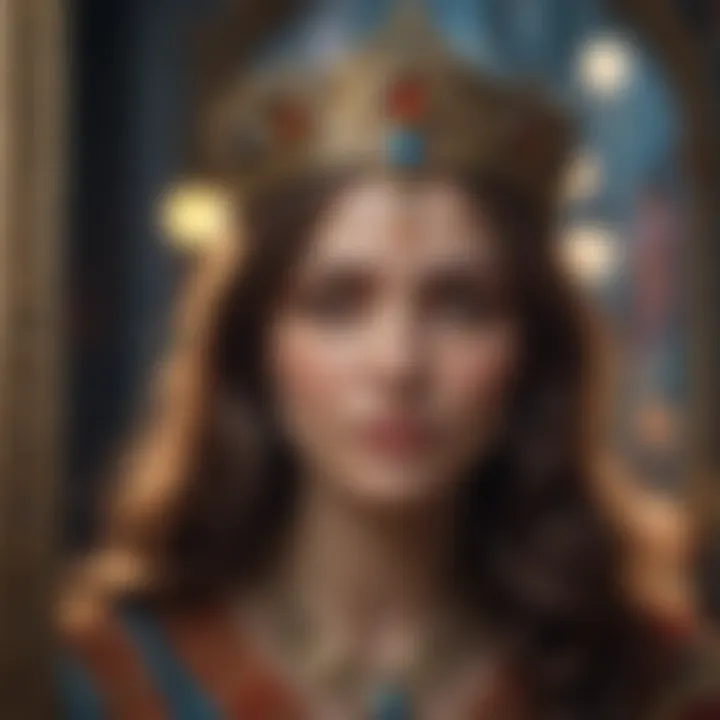
This section aims to delve into two pivotal areas: online tarot reading platforms and digital art tools for tarot creation. Understanding these elements is crucial for grasping the contemporary landscape of tarot art and practice.
Online Tarot Reading Platforms
Online tarot reading platforms have risen like a phoenix in today's fast-paced environment. Not only do they provide a space for guidance seekers to find clarity, but they also introduce aspiring readers to a broader audience. The significance of these platforms cannot be overstated. Here are some key points about their importance:
- Accessibility: People can access tarot readings from the comfort of their homes, breaking geographical barriers. A seeker in New York can connect with a reader in Tokyo in the blink of an eye.
- Diversity of Techniques: Online platforms often showcase a variety of tarot methodologies. This can include everything from traditional interpretations to innovative approaches that blend different practices.
- Community and Support: Many platforms foster community interactions, allowing users to discuss experiences, seek advice, or share insights, enhancing personal growth.
However, it’s essential for users to approach these platforms with discernment. Different sites offer varying authenticity and quality. Always look for reviews or recommendations before diving into a reading.
Digital Art Tools for Tarot Creation
The tools available for digital artwork have transformed how tarot decks are designed. Artists today can utilize various software to create visually captivating decks that reflect contemporary themes and individual interpretations. Some notable tools that have made a splash in the tarot art scene include:
- Adobe Illustrator: Renowned for its vector graphics capabilities, it allows artists to create intricate designs that can be easily resized without losing quality.
- Procreate: Especially popular among illustrators, this app offers a wide array of brushes and styles that empower artists to explore creative avenues not possible with traditional media.
- Photoshop: A staple for many, this tool is indispensable for editing and compositional adjustments, allowing for a polished final product.
"The true power of digital media lies in its ability to democratize creativity, turning the once exclusive world of tarot art into an inclusive space for all."
In the ever-evolving world of tarot, blending tradition with digital innovation can yield fantastic outcomes. The availability of online platforms and digital tools allows for a richer exploration of tarot, giving both creators and followers the tools they need to thrive in this mystical journey.
Ethics and Cultural Sensitivity in Tarot Art
The conversation around ethics and cultural sensitivity in tarot art is all the more crucial in a world where diverse influences shape artistic expressions. Tarot cards, steeped in history and rich in symbolism, often incorporate images, themes, and motifs from various cultures. As tarot artists tap into these deep wells of inspiration, they must navigate the thin line between appropriation and appreciation. Understanding this distinction is not just an ethical consideration, it also affects how the art is perceived and interpreted.
When approaching the art of tarot, one must acknowledge that many symbols and imagery originate from cultural traditions that carry significant meaning. Misusing these elements without acknowledging their origins can lead to misunderstandings and even perpetuate stereotypes. This underlines the necessity for artists to approach their work with a level of respect and comprehension regarding the cultural contexts they are drawing from.
Some benefits of maintaining cultural sensitivity include:
- Enhancing Authenticity: By being informed and respectful of the sources of inspiration, tarot decks can resonate more authentically with users.
- Building Trust: Artists who demonstrate an understanding of diverse heritages establish credibility among both consumers and fellow creators.
- Fostering Inclusivity: Recognizing and embracing a broad range of influences makes the tarot community more inviting to a wider audience.
Appropriation vs. Appreciation
In the realm of tarot arts, the terms appropriation and appreciation often surface as points of contention. Appropriation refers to the use of symbols or ideas from one culture by artists, typically from a more dominant culture, usually without a comprehensive understanding or respect for the originating culture. This often leads to oversimplification or misrepresentation, stripping the cultural context and importance from the original symbols.
Conversely, appreciation involves a respectful acknowledgment and understanding of cultural symbols. It embraces the richness of the traditions and aims to honor them in the artwork being created. For example, an artist drawing from Native American motifs should ideally engage with those communities, learning their stories and meanings, rather than simply borrowing their imagery for aesthetic value.
This distinction plays a vital role in how tarot art is interpreted. A tarot deck influenced by a culture's symbolism in a respectful manner can lead to deeper connections and insights. In contrast, artwork that comes across as appropriation can foster mistrust and deter engagement.
Responsibilities of Tarot Artists
Tarot artists hold immense responsibility when crafting decks that resonate with users. With great power comes great responsibility, as the decisions made in design can affect not just aesthetics, but also the historical and cultural narratives that underlie the symbolism.
Artists are encouraged to research and engage with the subjects they incorporate into their designs. Some key responsibilities include:
- Conducting Thorough Research: Understand the historical and cultural significance of the symbols and designs used.
- Seeking Authentic Collaborations: Where applicable, involve members of the cultures represented in the art, fostering a collaborative approach that honors their heritage.
- Adopting a Humble Attitude: Acknowledge that art can be interpreted differently across cultural lines, and remain open to feedback that may reveal oversight.
As tarot continues to evolve, the ethics and considerations surrounding artwork must remain at the forefront of the creators' minds. Artists who navigate these complexities thoughtfully not only enhance the interpretative value of their decks but also contribute to a more inclusive and respectful artistic landscape.
Future Trends in Tarot Artwork
The world of tarot art is not static. It’s constantly evolving, reflecting both changes in societal attitudes and technological advancements. Understanding these future trends isn't just a passing interest; it's essential for anyone engaged in the astrological arts. These trends not only enhance the connection between the user and the cards, but they also play a pivotal role in shaping the very interpretations and experiences one can have with tarot.
Emerging Themes in Representational Content
In recent years, tarot decks have been embracing broader themes that resonate with contemporary audiences. There's a notable shift towards inclusivity in representation, moving away from traditional depictions that often sidelined diverse identities. This emerging trend brings forth artwork that not only reflects varied races and genders but also represents different sexual orientations, cultural backgrounds, and spiritual perspectives.
This shift challenges the conventional archetypes found in older decks—think about how the classic Rider-Waite deck often depicts Eurocentric imagery. New themes like self-discovery, mental health, and environmental awareness are being visualized through creative illustrations, broadening the interpretations of the cards.
For example, artists now use vibrant colors and intricate patterns to portray stories that resonate with personal experiences, tapping into collective consciousness. Some decks even integrate modern symbols and societal references that speak to current issues, facilitating a deeper connection between the user and the reading process.
- Identity and Belonging: Artworks often explore notions of identity, emphasizing connection and belonging among individuals.
- Environmental Consciousness: Many illustrations depict nature and elements, reinforcing the relationship humans share with the earth and their responsibilities towards it.
"The artwork in tarot has the potential to heal, to teach, and to bring us together in ways we never thought possible."
The Impact of Augmented Reality on Tarot Experience
As technology advances, augmented reality (AR) is beginning to carve a niche within the tarot community. This trend is particularly exciting as AR offers a multi-dimensional way to engage with tarot cards. Imagine holding your phone over a card and watching images come to life, providing an interactive experience that enhances traditional meanings.
Players of the tarot game can experience narratives unfolding right before their eyes, deepening their understanding of the card's significance. AR allows users to see not just images but also interpretative layers of meaning in real-time.
Additionally, AR can bridge the gap between beginners and seasoned readers. For novices, seeing visual cues, tips, or guidance through the lens of augmented reality can demystify the reading process. It's akin to having a personal guide who can provide instant insights as one engages with the art itself. Some future tarot deck releases even promise unique AR experiences, offering layers of understanding that static images can't convey.
To sum up, the integration of emerging themes and AR technology into tarot artwork not only reflects the shifting dynamics within society but also enhances the way people interact with tarot. This approach enables a richer experience that merges intuition with modern innovation, positioning tarot not just as a divination tool but as a dynamic avenue of personal growth and exploration.
Ending: The Interplay of Art and Intuition in Tarot
The relationship between art and intuition in tarot is a fascinating tapestry woven with complex threads. Each tarot card carries not only imagery but also layers of meaning that resonate with the reader on a personal and intuitive level. Art plays a crucial role in enhancing these meanings, serving as a bridge between the conscious mind and the undercurrents of the subconscious. By interpreting the visuals in the context of one's life experiences and emotional landscape, tarot readings can transform into profound reflections on choice, fate, and personal growth.
The process is not as straightforward as it may seem. Each artwork, whether bold or subtle, carries a vibrancy that can evoke deep feelings and perceptions. The symbolism, colors, and artistic choices somehow dance together, drawing the reader into a more intimate engagement with the message of the cards. This is where intuition comes into play.
"Art is the most beautiful of all lies; in tarot, it is the catalyst that unveils the truth within."
In this way, both art and intuition shape the experience of tarot readings. The colors can uplift or dim the mood, while symbols resonate differently with each individual, depending on their personal story. As an astrological enthusiast, recognizing this interplay can significantly enrich your readings.
Reflecting on the Visual Language of Tarot
The visual language of tarot is crafted with intention and care. Each image is a narrative, rich with symbols and allegories. Looking closely at tarot art means understanding that it communicates on multiple levels. The visuals prompt questions, inspire insights, and manifest feelings that shape one's interpretation.
In tarot, consider the following elements:
- Imagery: The figures, backgrounds, and objects within the cards are meticulously designed to tell a story. For example, the presence of water may symbolize emotions, while a barren landscape could hint at a sense of loss or longing.
- Color Schemes: The hues don’t just fill the canvas; they are imbued with meaning. Warm colors like reds and yellows often evoke energy and passion, whereas cool colors such as blues may promote calmness and reflection.
- Symbols: Common elements—like the moon, sun, or animals—carry universal meanings that can enhance the reading's impact. Each symbol may resonate differently based on personal associations.
The engagement with tarot art is not merely a superficial glance. Just as a great painting invites deeper contemplation, so does a well-crafted tarot card. Therefore, attuning to this visual language can deepen not just your connection with the cards, but also with your intuitive abilities.
Engaging thoughtfully with tarot imagery invites practitioners to stay open to insights and revelations that may not be immediately apparent. As you navigate your journey through this intricate world of tarot, remember that each reading is a unique fusion of art and intuition, beckoning for your exploration and understanding.



